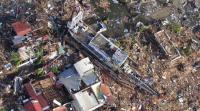
A survivor of “Yolanda” breaks into a smile of relief as she welcomes a care package from President Aquino at the Palo municipal hall in Leyte province. FILE PHOTO It’s unheard of in international humanitarian circles: Communities either flattened or swept away by one of the world’s strongest typhoons, losing their loved ones and most everything they own, are rebuilding their homes and going back to work, eager to start anew just two months after the disaster. To Yuri Afanasiev, senior recovery coordinator of the United Nations Development Program (UNDP), the speed by which people in the communities ravaged by Supertyphoon “Yolanda” (international name: Haiyan) on Nov. 8 last year are recovering is encouraging. “We have never seen a recovery happen so quick. And many of us have been in many different disasters,” Afanasiev said. Afanasiev, the UNDP resident representative in Bosnia and Herzegovina, is leading his agency’s early recovery mission in the communities destroyed by Yolanda in central Philippines. He flew to the Philippines as part of the United Nations’ “surge” or rapid deployment of specialized personnel for major emergencies. Yolanda is one of four Level 3 emergencies in the world, the highest in the UN disaster scale. The others are the humanitarian crises spurred by conflict in South Sudan, the Central African Republic and Syria. “For the UNDP to be speaking to you about ongoing field early recovery operations essentially at the end of the second month is unheard of,” Afanasiev told the Inquirer in an interview on Read More …







